2024届高考英语复习同位语从句课件(共19张PPT)
文档属性
| 名称 | 2024届高考英语复习同位语从句课件(共19张PPT) | 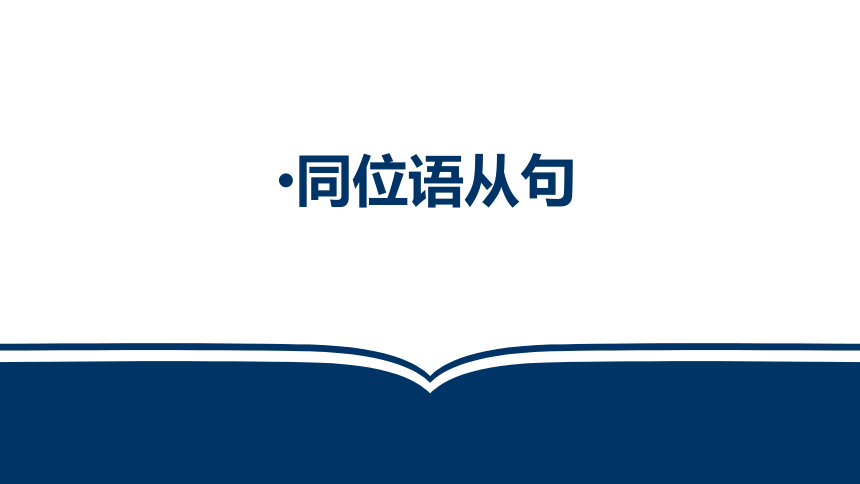 | |
| 格式 | pptx | ||
| 文件大小 | 208.7KB | ||
| 资源类型 | 教案 | ||
| 版本资源 | 人教版(2019) | ||
| 科目 | 英语 | ||
| 更新时间 | 2023-07-03 08:54:11 | ||
图片预览

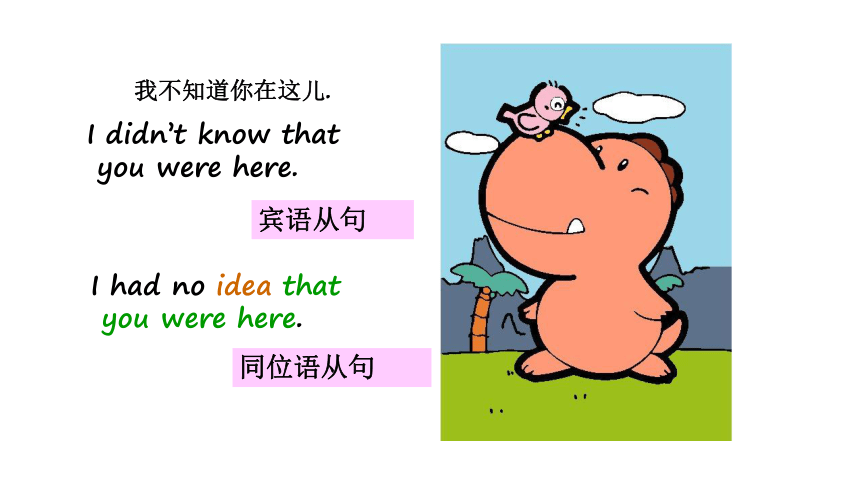
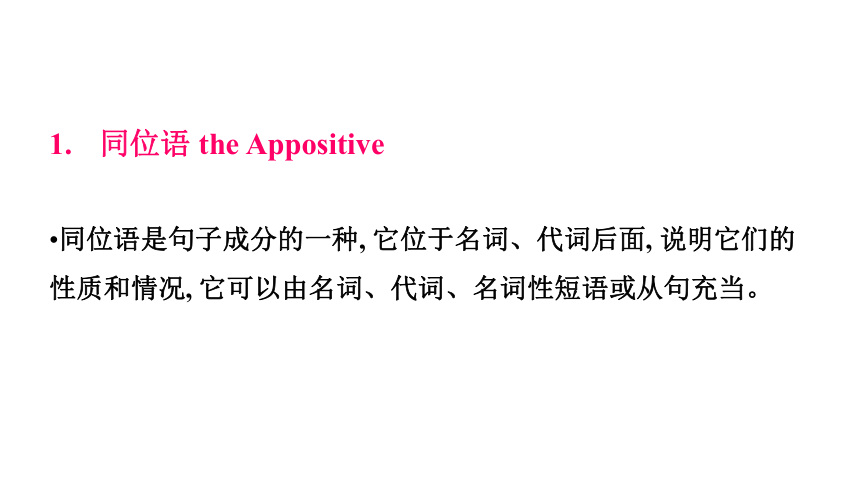
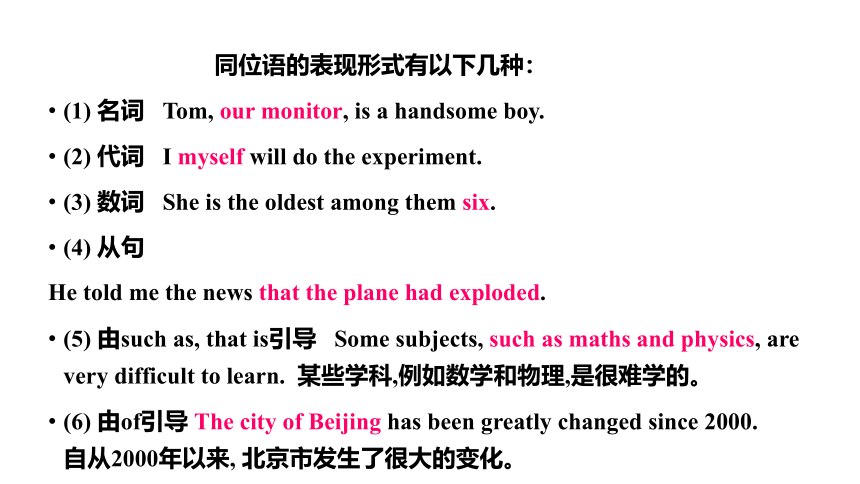
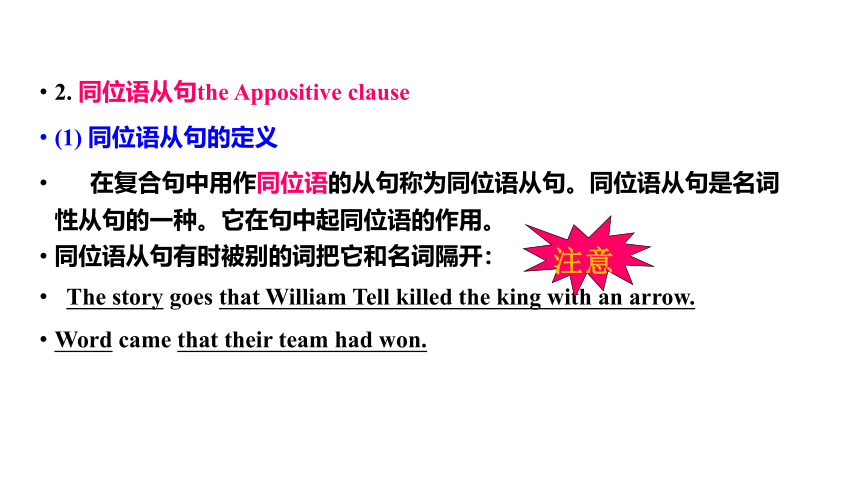

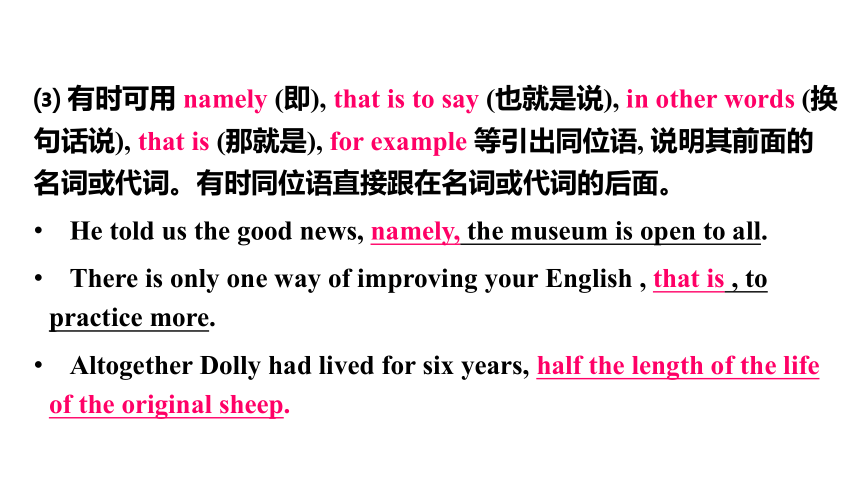
文档简介
(共19张PPT)
同位语从句
我不知道你在这儿.
I didn’t know that
you were here.
I had no idea that
you were here.
宾语从句
同位语从句
同位语 the Appositive
同位语是句子成分的一种, 它位于名词、代词后面, 说明它们的性质和情况, 它可以由名词、代词、名词性短语或从句充当。
同位语的表现形式有以下几种:
(1) 名词 Tom, our monitor, is a handsome boy.
(2) 代词 I myself will do the experiment.
(3) 数词 She is the oldest among them six.
(4) 从句
He told me the news that the plane had exploded.
(5) 由such as, that is引导 Some subjects, such as maths and physics, are very difficult to learn. 某些学科,例如数学和物理,是很难学的。
(6) 由of引导 The city of Beijing has been greatly changed since 2000. 自从2000年以来, 北京市发生了很大的变化。
2. 同位语从句the Appositive clause
(1) 同位语从句的定义
在复合句中用作同位语的从句称为同位语从句。同位语从句是名词性从句的一种。它在句中起同位语的作用。
同位语从句有时被别的词把它和名词隔开:
The story goes that William Tell killed the king with an arrow.
Word came that their team had won.
注意
⑵ 同位语从句的表现形式:
① 由that引导
The fact that you haven’t enough time to do the work is simply unbelievable.
The hope that he may come here is not gone yet.
② 由whether引导
The question whether we need more time to do the work has not been discussed.
③ 由when引导
I have no idea when they will go.
⑶ 有时可用 namely (即), that is to say (也就是说), in other words (换句话说), that is (那就是), for example 等引出同位语, 说明其前面的名词或代词。有时同位语直接跟在名词或代词的后面。
He told us the good news, namely, the museum is open to all.
There is only one way of improving your English , that is , to practice more.
Altogether Dolly had lived for six years, half the length of the life of the original sheep.
它一般放在fact, news, idea, truth , hope , problem, information, belief, thought, doubt, promise, question , possibility,, message 等名词的后面, 对前面的名词作进一步的解释, 说明前面名词的具体含义。引导同位语从句的词有连词that, 连接副词how, when, where, whether, what等。
同位语从句的引导词常用that, wh-, how等。
e.g.
I have no idea
when he will be back.
how he can get the treasure.
where the concert will be hold.
who can finish the work.
why it happened.
which pen is mine.
what we should do next.
whom they are talking about.
whether it’ll rain tomorrow.
that our football team won
the game.
同位语从句的引导词
that引导的同位语从句
The news that our football team won the match was encouraging.
我们足球队赢了比赛的消息令人鼓舞。
主语:The news
系动词:was
表语:encouraging
引导词:that
同位语从句:that our football team won the match.
that无意义,不作成分,但不可省略。
whether引导的同位语从句
I have no idea whether the meeting will be held.
我不知道会议是否会举行。
主语:I
谓语:have
宾语:no idea
引导词:whether
同位语从句:whether the meeting will be held.
whether表示“是否”,不作成分,不可用if代替。
连接代词引导的同位语从句
They have no idea what he is doing.
他们不知道他在做什么。
主语:They
谓语:have
宾语:no idea
引导词:what
同位语从句:what he is doing.
连接副词引导的同位语从句
We have not settled the question where we are going to spend our summer vacation.
我们还没有解决今年夏天去哪里度假这个问题。
主语:we
谓语:have not settled
宾语:the question
引导词:where
同位语从句:where we are going to spend our summer vacation.
doubt与同位语从句
名词doubt(怀疑)用于肯定句中,其后面的同位语从句用whether引导;
no doubt (毫无疑问)用于否定句中,其后面的同位语从句用that引导。
There is no doubt that he will come.
毫无疑问他会来的。(no doubt表示肯定概念)
There is doubt whether he can win the first place in the competition.
他能否在比赛中获得第一名还存疑。(doubt表示不确定的概念).
同位语从句:
在主从复合句中作某一名词尤其是抽象名词的同位语,是对名词的内容进行说明的从句。
The news that our team has won the match is true. (说明名词news) 句子完整
定语从句:
在主从复合句中作某一名词或代词的定语,是修饰名词、对名词进行修饰和限定的从句。
The news that he told me is true.(修饰名词news) 句子不完整
同位语从句和定语从句的区别辨析
1. The fact ____ she works hard is well known to us all.
A. that B. what C. why D. which
2. The fact ____ he was successful proves his ability.
A. that B. what C. which D. why
3. The news ____ he was kidnapped surprised us greatly.
A. what B. that C. why D. when
4. His suggestion ____ the meeting be delayed was turned down.
A. which B. that C./ D. it
A
A
练一练!
A
A
B
B
5. I have no idea ____ he will start.
A. when B. that C. what D./
6. I've come from the government with a message ____ the meeting won't be held tomorrow.
A. if B. that C. whether D. which
7. The thought ____ he might fail in the exam worried him.
A. when B. which C. what D. that
8. The order ____ the prisoner be set free arrived too late.
A. which B. whether C. that D. what
B
A
D
C
Thanks For LISTENING
同位语从句
我不知道你在这儿.
I didn’t know that
you were here.
I had no idea that
you were here.
宾语从句
同位语从句
同位语 the Appositive
同位语是句子成分的一种, 它位于名词、代词后面, 说明它们的性质和情况, 它可以由名词、代词、名词性短语或从句充当。
同位语的表现形式有以下几种:
(1) 名词 Tom, our monitor, is a handsome boy.
(2) 代词 I myself will do the experiment.
(3) 数词 She is the oldest among them six.
(4) 从句
He told me the news that the plane had exploded.
(5) 由such as, that is引导 Some subjects, such as maths and physics, are very difficult to learn. 某些学科,例如数学和物理,是很难学的。
(6) 由of引导 The city of Beijing has been greatly changed since 2000. 自从2000年以来, 北京市发生了很大的变化。
2. 同位语从句the Appositive clause
(1) 同位语从句的定义
在复合句中用作同位语的从句称为同位语从句。同位语从句是名词性从句的一种。它在句中起同位语的作用。
同位语从句有时被别的词把它和名词隔开:
The story goes that William Tell killed the king with an arrow.
Word came that their team had won.
注意
⑵ 同位语从句的表现形式:
① 由that引导
The fact that you haven’t enough time to do the work is simply unbelievable.
The hope that he may come here is not gone yet.
② 由whether引导
The question whether we need more time to do the work has not been discussed.
③ 由when引导
I have no idea when they will go.
⑶ 有时可用 namely (即), that is to say (也就是说), in other words (换句话说), that is (那就是), for example 等引出同位语, 说明其前面的名词或代词。有时同位语直接跟在名词或代词的后面。
He told us the good news, namely, the museum is open to all.
There is only one way of improving your English , that is , to practice more.
Altogether Dolly had lived for six years, half the length of the life of the original sheep.
它一般放在fact, news, idea, truth , hope , problem, information, belief, thought, doubt, promise, question , possibility,, message 等名词的后面, 对前面的名词作进一步的解释, 说明前面名词的具体含义。引导同位语从句的词有连词that, 连接副词how, when, where, whether, what等。
同位语从句的引导词常用that, wh-, how等。
e.g.
I have no idea
when he will be back.
how he can get the treasure.
where the concert will be hold.
who can finish the work.
why it happened.
which pen is mine.
what we should do next.
whom they are talking about.
whether it’ll rain tomorrow.
that our football team won
the game.
同位语从句的引导词
that引导的同位语从句
The news that our football team won the match was encouraging.
我们足球队赢了比赛的消息令人鼓舞。
主语:The news
系动词:was
表语:encouraging
引导词:that
同位语从句:that our football team won the match.
that无意义,不作成分,但不可省略。
whether引导的同位语从句
I have no idea whether the meeting will be held.
我不知道会议是否会举行。
主语:I
谓语:have
宾语:no idea
引导词:whether
同位语从句:whether the meeting will be held.
whether表示“是否”,不作成分,不可用if代替。
连接代词引导的同位语从句
They have no idea what he is doing.
他们不知道他在做什么。
主语:They
谓语:have
宾语:no idea
引导词:what
同位语从句:what he is doing.
连接副词引导的同位语从句
We have not settled the question where we are going to spend our summer vacation.
我们还没有解决今年夏天去哪里度假这个问题。
主语:we
谓语:have not settled
宾语:the question
引导词:where
同位语从句:where we are going to spend our summer vacation.
doubt与同位语从句
名词doubt(怀疑)用于肯定句中,其后面的同位语从句用whether引导;
no doubt (毫无疑问)用于否定句中,其后面的同位语从句用that引导。
There is no doubt that he will come.
毫无疑问他会来的。(no doubt表示肯定概念)
There is doubt whether he can win the first place in the competition.
他能否在比赛中获得第一名还存疑。(doubt表示不确定的概念).
同位语从句:
在主从复合句中作某一名词尤其是抽象名词的同位语,是对名词的内容进行说明的从句。
The news that our team has won the match is true. (说明名词news) 句子完整
定语从句:
在主从复合句中作某一名词或代词的定语,是修饰名词、对名词进行修饰和限定的从句。
The news that he told me is true.(修饰名词news) 句子不完整
同位语从句和定语从句的区别辨析
1. The fact ____ she works hard is well known to us all.
A. that B. what C. why D. which
2. The fact ____ he was successful proves his ability.
A. that B. what C. which D. why
3. The news ____ he was kidnapped surprised us greatly.
A. what B. that C. why D. when
4. His suggestion ____ the meeting be delayed was turned down.
A. which B. that C./ D. it
A
A
练一练!
A
A
B
B
5. I have no idea ____ he will start.
A. when B. that C. what D./
6. I've come from the government with a message ____ the meeting won't be held tomorrow.
A. if B. that C. whether D. which
7. The thought ____ he might fail in the exam worried him.
A. when B. which C. what D. that
8. The order ____ the prisoner be set free arrived too late.
A. which B. whether C. that D. what
B
A
D
C
Thanks For LISTENING
